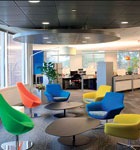Colony Realty Partners (CRP) may only be six years old, but the real estate investment company’s founding principals have more than eight decades of combined experience in the field. With that sort of backbone comes an unparalleled understanding of the market, which is why the firm made sustainability a core concept from the start.

CRP’s 2200 Cabot Drive property was 20 years old when the company first acquired it in 2007. In just four years, green initiatives have resulted in a 17% reduction in energy use.
According to Robert Holmes, the managing director of asset management at CRP, the motivation bhind the company’s commitment to sustainability is twofold. “Not only is it the right thing to do from a sustainability standpoint, but it’s just the responsible way to run a business,” he says. “It doesn’t matter what industry you’re in; you have to be efficient, and that means giving back when you can and never using more than you need to.”
CRP currently manages more than 150 individual investments throughout the United States, including office, industrial, multifamily, and retail properties. For now, the company’s main focus is getting all its office properties to run as efficiently as possible—a directive the staff tackles from a number of angles. The office properties in CRP’s portfolio are registered with the Energy Star Portfolio Manager, enabling the firm to benchmark each building’s performance. CRP also integrates the USGBC’s LEED-EB rating system, with two in-house LEED-accredited professionals establishing sustainability goals for each property. It should come as no surprise then, that nearly half of CRP’s office properties are either LEED-registered or -certified and that all of them currently have sustainability programs in place such as recycling plans and green cleaning services.

The Cabot property underwent extensive retrofitting that enhanced its energy efficiency, including the installation of new interior lights. All common-area lighting is now controlled by toggle switches, occupancy sensors, and programmable lighting controllers.
“It was easier for us to focus on office properties first because it’s more efficient to regulate green practices and track methodologies,” Holmes says. “We are now focusing on single-tenant industrial properties and evaluating how to make them as sustainable as our office spaces.”
In many ways, CRP’s 2200 Cabot Drive property, acquired in 2007 and located in Lisle, Illinois, exemplifies the company’s approach to sustainability. The firm scrutinized 11 properties in the Chicagoland area, with a gap analysis for each one, before identifying a 20-year-old building for a pilot program to maximize sustainable operations and obtain the LEED-EB rating. The Cabot building was well taken care of by its previous owner, but it took CRP’s keen eye to see the structure’s sustainable potential.
The Cabot property underwent extensive retrofitting that enhanced its energy efficiency, including the installation of new interior lights, and all common-area lighting is now controlled by toggle switches, occupancy sensors, and programmable lighting controllers. By also taking small but important steps, such as posting key energy tips around the building, CRP ensured the Cabot building’s shift toward maximum energy efficiency would be fast-moving. When CRP acquired the structure, the Energy Star rating was 63, and 15 months later, in March of 2009, the rating was 75. The current rating is 87, representing a 17 percent overall reduction in energy use.
Many of CRP’s properties, such as its 5100 River Road and 155 Pfingsten buildings in Illinois, are making similar strides, so it’s clear the company isn’t resting on its laurels or overconcerning itself with what others in the industry are doing. Holmes and his team are continuously pushing forward. “When you’re evaluating every detail, you don’t really have time to look up and recognize what your competitors are doing,” Holmes said. “The best way to continuously evolve is to implement, evaluate, and adjust—to keep moving the initiatives forward, making each building more efficient as you go.”

